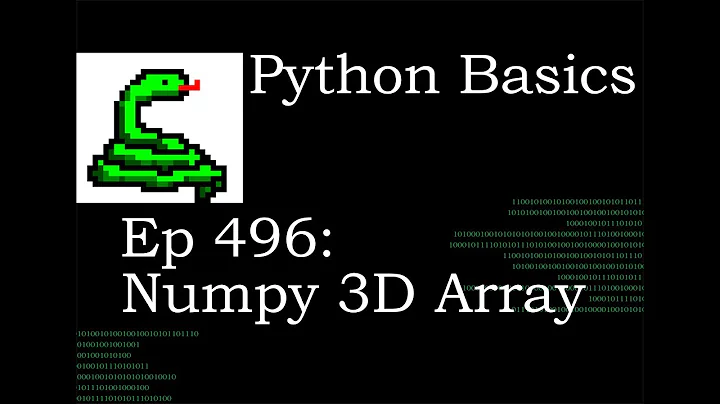Creating a numpy array of 3D coordinates from three 1D arrays
Solution 1
To use numpy mesh grid on the above example the following will work:
np.vstack(np.meshgrid(x_p,y_p,z_p)).reshape(3,-1).T
Numpy meshgrid for grids of more then two dimensions require numpy 1.7. To circumvent this and pulling the relevant data from the source code.
def ndmesh(*xi,**kwargs):
if len(xi) < 2:
msg = 'meshgrid() takes 2 or more arguments (%d given)' % int(len(xi) > 0)
raise ValueError(msg)
args = np.atleast_1d(*xi)
ndim = len(args)
copy_ = kwargs.get('copy', True)
s0 = (1,) * ndim
output = [x.reshape(s0[:i] + (-1,) + s0[i + 1::]) for i, x in enumerate(args)]
shape = [x.size for x in output]
# Return the full N-D matrix (not only the 1-D vector)
if copy_:
mult_fact = np.ones(shape, dtype=int)
return [x * mult_fact for x in output]
else:
return np.broadcast_arrays(*output)
Checking the result:
print np.vstack((ndmesh(x_p,y_p,z_p))).reshape(3,-1).T
[[ 1. 2. 8.]
[ 1. 2. 9.]
[ 1. 3. 8.]
....
[ 5. 3. 9.]
[ 5. 4. 8.]
[ 5. 4. 9.]]
For the above example:
%timeit sol2()
10000 loops, best of 3: 56.1 us per loop
%timeit np.vstack((ndmesh(x_p,y_p,z_p))).reshape(3,-1).T
10000 loops, best of 3: 55.1 us per loop
For when each dimension is 100:
%timeit sol2()
1 loops, best of 3: 655 ms per loop
In [10]:
%timeit points = np.vstack((ndmesh(x_p,y_p,z_p))).reshape(3,-1).T
10 loops, best of 3: 21.8 ms per loop
Depending on what you want to do with the data, you can return a view:
%timeit np.vstack((ndmesh(x_p,y_p,z_p,copy=False))).reshape(3,-1).T
100 loops, best of 3: 8.16 ms per loop
Solution 2
For your specific example, mgrid is quite useful.:
In [1]: import numpy as np
In [2]: points = np.mgrid[1:6, 2:5, 8:10]
In [3]: points.reshape(3, -1).T
Out[3]:
array([[1, 2, 8],
[1, 2, 9],
[1, 3, 8],
[1, 3, 9],
[1, 4, 8],
[1, 4, 9],
[2, 2, 8],
[2, 2, 9],
[2, 3, 8],
[2, 3, 9],
[2, 4, 8],
[2, 4, 9],
[3, 2, 8],
[3, 2, 9],
[3, 3, 8],
[3, 3, 9],
[3, 4, 8],
[3, 4, 9],
[4, 2, 8],
[4, 2, 9],
[4, 3, 8],
[4, 3, 9],
[4, 4, 8],
[4, 4, 9],
[5, 2, 8],
[5, 2, 9],
[5, 3, 8],
[5, 3, 9],
[5, 4, 8],
[5, 4, 9]])
More generally, if you have specific arrays that you want to do this with, you'd use meshgrid instead of mgrid. However, you'll need numpy 1.7 or later for it to work in more than two dimensions.
Solution 3
You can use itertools.product:
def sol1():
points = np.array( list(product(x_p, y_p, z_p)) )
Another solution using iterators and np.take showed to be about 3X faster for your case:
from itertools import izip, product
def sol2():
points = np.empty((len(x_p)*len(y_p)*len(z_p),3))
xi,yi,zi = izip(*product( xrange(len(x_p)),
xrange(len(y_p)),
xrange(len(z_p)) ))
points[:,0] = np.take(x_p,xi)
points[:,1] = np.take(y_p,yi)
points[:,2] = np.take(z_p,zi)
return points
Timing results:
In [3]: timeit sol1()
10000 loops, best of 3: 126 µs per loop
In [4]: timeit sol2()
10000 loops, best of 3: 42.9 µs per loop
In [6]: timeit ops()
10000 loops, best of 3: 59 µs per loop
In [11]: timeit joekingtons() # with your permission Joe...
10000 loops, best of 3: 56.2 µs per loop
So, only my second solution and Joe Kington's solution would give you some performance gain...
Solution 4
For those who had to stay with numpy <1.7.x, here is a simple two-liner solution:
g_p=np.zeros((x_p.size, y_p.size, z_p.size))
array_you_want=array(zip(*[item.flatten() for item in \
[g_p+x_p[...,np.newaxis,np.newaxis],\
g_p+y_p[...,np.newaxis],\
g_p+z_p]]))
Very easy to expand to even higher dimenision as well. Cheers!
Related videos on Youtube
Andrew McLeod
Updated on July 09, 2022Comments
-
Andrew McLeod almost 2 years
Suppose I have three arbitrary 1D arrays, for example:
x_p = np.array((1.0, 2.0, 3.0, 4.0, 5.0)) y_p = np.array((2.0, 3.0, 4.0)) z_p = np.array((8.0, 9.0))These three arrays represent sampling intervals in a 3D grid, and I want to construct a 1D array of three-dimensional vectors for all intersections, something like
points = np.array([[1.0, 2.0, 8.0], [1.0, 2.0, 9.0], [1.0, 3.0, 8.0], ... [5.0, 4.0, 9.0]])Order doesn't actually matter for this. The obvious way to generate them:
npoints = len(x_p) * len(y_p) * len(z_p) points = np.zeros((npoints, 3)) i = 0 for x in x_p: for y in y_p: for z in z_p: points[i, :] = (x, y, z) i += 1So the question is... is there a faster way? I have looked but not found (possibly just failed to find the right Google keywords).
I am currently using this:
npoints = len(x_p) * len(y_p) * len(z_p) points = np.zeros((npoints, 3)) i = 0 nz = len(z_p) for x in x_p: for y in y_p: points[i:i+nz, 0] = x points[i:i+nz, 1] = y points[i:i+nz, 2] = z_p i += nzbut I feel like I am missing some clever fancy Numpy way?
-
Andrew McLeod over 10 yearsThis question has been marked as a duplicate; it is a similar question, but (obviously I am biased) I think my question is a simpler phrasing of a more general problem. I also think the answer on this question is better; use of meshgrid seems to be the simplest, fastest solution.
-
tom10 almost 9 yearsAlso, the extension from 2D to 3D is non-obvious in my opinion. Seeing that the answers have similar structures implies that the straight-forward extensions are a good start, but, a priori, it wasn't clear that these would work.
-
-
Daniel over 10 yearsSpecifically with meshgrid in numpy 1.7:
np.vstack(np.meshgrid(x_p,y_p,z_p)).reshape(3,-1).T -
chthonicdaemon over 10 yearsAccording to my timings, your second solution runs in 66% of the time of the OP's solution with the preallocation, which runs almost as fast as the mgrid solution. Perhaps you should show timings? You can also shave of a little time by using np.empty instead of np.zeros
-
Daniel over 10 yearsThis is fine for small systems, however it scales very poorly. For such systems its likely much better to take the (14 microsecond!) performance penalty for cleaner code. Nd meshgrid is consistently faster across all sizes and can be easily used by copy/pasting the numpy source code.
-
 Saullo G. P. Castro over 10 years@Ophion The problem would be if in
Saullo G. P. Castro over 10 years@Ophion The problem would be if inx_p, y_p or z_pyou had some non-integer values irregularly spaced likenp.array([0.1, 0.2, 0.6, 1., 2., 3.])and so forth... -
Daniel over 10 years@Saullo Castro meshgrid takes this into account.
-
Andrew McLeod over 10 yearsWhen I tried this (albeit not in a particularly good way, only doing a few repeats) with timeit with three arrays of 256 each, it took a bit longer than a minute; faster than the naive for loop method (over two minutes) but slower than the faster for loop method which only looped over x_p and y_p; that took about 20-30 seconds.
-
Andrew McLeod over 10 yearsThis works well for me, even with large grids. I had intended to write the question to not assume that the spacings were even; actually in my case they are but I think for the sake of generality the meshgrid solution is the best answer for this question.
-
Andrew McLeod over 10 yearsFortunately I have Numpy 1.7. For my particular case where the dimensions will probably be at least 128, and can be more (large data sets), the mgrid/meshgrid solution seems to work best and is slightly cleaner than my original two-for-loop solution.
-
Daniel over 10 yearsAs a note, if you are not using sparse arrays
ndmeshis equivalent tonp.meshgridso all the timings and keywords will be identical.









